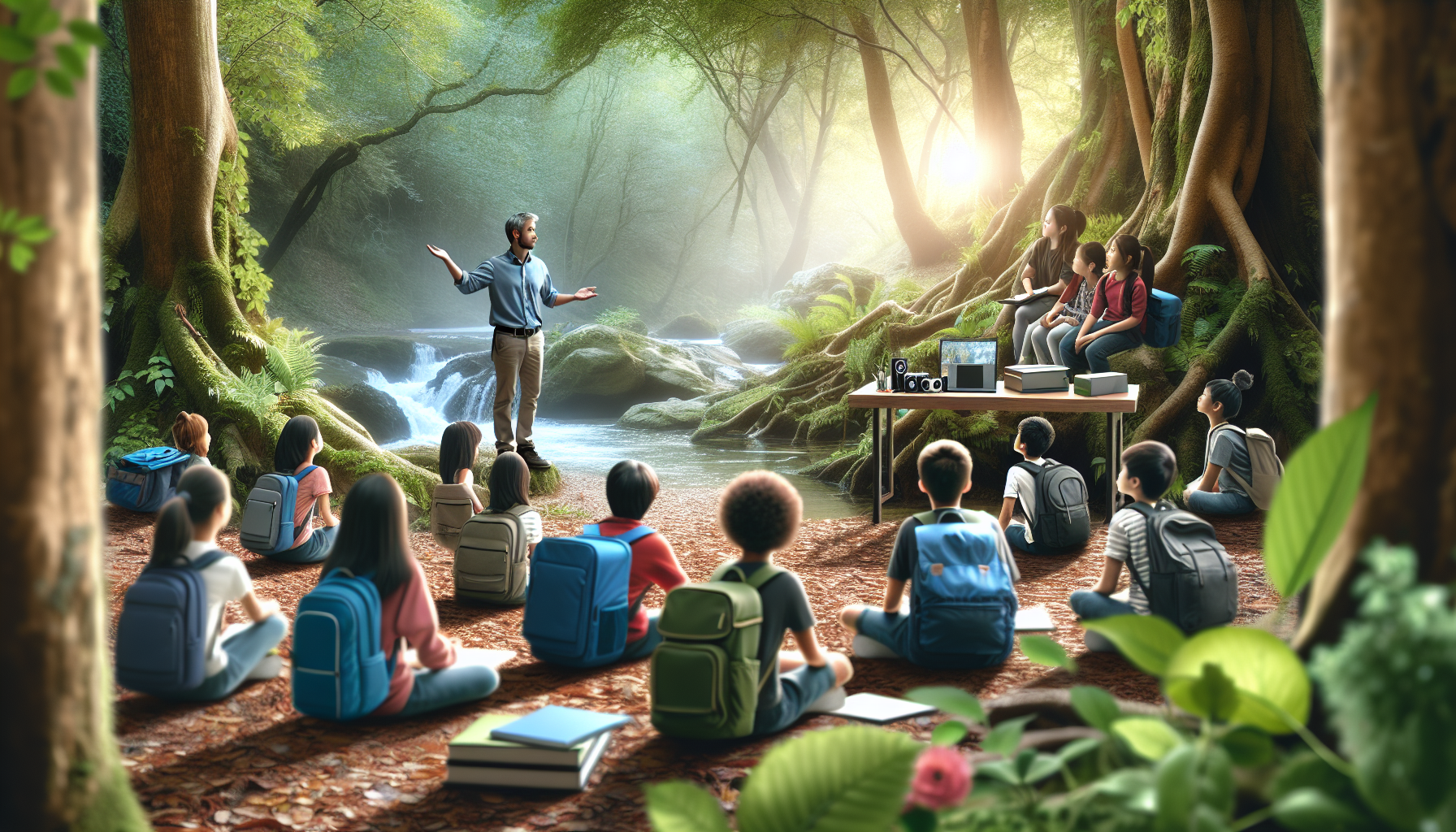In a world increasingly dominated by screens, structured classrooms, and standardized testing, a quiet revolution is taking root beneath the open skies and rustling leaves of the great outdoors. Imagine an educational paradigm where textbooks are replaced by towering trees, lessons are etched into the sandy soil of meandering trails, and knowledge flows as freely as a mountain stream. Welcome to the realm of trailblazing education: teaching while trekking through nature’s vast and varied classroom. 🌿
As the sun peeks over the horizon, casting golden rays across dew-kissed meadows, students and educators alike lace up their hiking boots, ready to embark on a journey that transcends the traditional bounds of schooling. This innovative approach to education is not merely about physical activity or the novelty of a classroom without walls; it’s a holistic method that integrates cognitive learning with emotional and physical development. In this article, we’ll delve into how this educational method nurtures creativity, fosters resilience, and instills a deep-seated respect for the natural world.
But why take education to the trails? The benefits of outdoor learning extend far beyond the fresh air and picturesque landscapes. Research indicates that students who engage in experiential learning in natural settings exhibit improved problem-solving skills, enhanced critical thinking, and heightened creativity. As they navigate the complexities of the wilderness, students learn valuable life skills that cannot be taught within the confines of four walls. This approach also emphasizes the interconnectedness of all living things, providing a tangible context for environmental education and inspiring the next generation of eco-conscious leaders. 🌍
Throughout this article, we’ll explore the multifaceted advantages of trail-based education. From the psychological benefits, such as reduced stress and increased focus, to the social and emotional growth that comes from teamwork and collaboration, teaching amidst the wild offers a unique set of advantages that conventional classrooms simply cannot replicate. We’ll also examine real-world examples of schools and programs that have successfully implemented this approach, highlighting the challenges they’ve faced and the triumphant stories of transformation they’ve witnessed.
Join us on this exploration of trailblazing education, where the earth becomes a living, breathing textbook, and every step forward is a lesson learned. Whether you’re an educator seeking inspiration, a parent curious about alternative schooling, or simply someone passionate about the great outdoors, this journey promises to enlighten and inspire. So grab your backpack and walking stick—let’s set off on an educational trek that promises to redefine what it means to learn. 🌱🏞️
The Intersection of Education and Nature: A New Paradigm
In a world increasingly dominated by technology and digital interactions, there is a burgeoning movement to reconnect with the natural environment. This shift is particularly evident in the field of education, where educators are exploring innovative ways to teach by embracing the great outdoors. Teaching while trekking through nature is more than a novel educational approach; it represents a comprehensive method to engage students on multiple levels — emotionally, physically, and intellectually. This blend of outdoor exploration with academic instruction not only enhances learning but also fosters a deeper connection with the environment. As we delve into this educational paradigm, it is crucial to examine the benefits, challenges, and methodologies that define this approach.
The idea of integrating nature into education is not entirely new. Historical perspectives reveal that education systems in ancient civilizations often incorporated outdoor learning as a fundamental component of their pedagogical strategies. However, the modern iteration of this approach is distinct in its intentional blend of rigorous academic content with experiential learning in natural settings. This methodology not only stimulates students’ curiosity and creativity but also nurtures essential life skills such as problem-solving, adaptability, and resilience.
Moreover, this educational approach aligns with contemporary research emphasizing the cognitive and psychological benefits of nature exposure. Studies have shown that learning in natural settings can reduce stress, improve concentration, and enhance overall mental well-being. These outcomes are particularly significant in an era where mental health challenges among students are on the rise. By fostering a holistic learning environment, educators can address both the academic and emotional needs of students, preparing them for future challenges with a balanced and robust foundation.
The Benefits of Outdoor Education
One of the most compelling advantages of integrating nature into education is the enhancement of student engagement. Traditional classroom settings can often stifle creativity and restrict students’ natural curiosity. In contrast, the dynamic and ever-changing landscapes of the great outdoors provide endless opportunities for exploration and discovery. This freedom encourages students to ask questions, seek answers, and engage deeply with the subject matter.
In addition to increased engagement, outdoor education has been linked to improved academic performance. When students learn through hands-on experiences and real-world applications, they are more likely to retain information and develop a deeper understanding of complex concepts. This experiential learning approach is particularly effective in subjects like science, geography, and environmental studies, where direct interaction with natural phenomena can significantly enhance comprehension.
Furthermore, outdoor education promotes physical health and well-being. In an age where sedentary lifestyles are becoming the norm, incorporating physical activity into the learning process can have profound effects on students’ physical health. Trekking, hiking, and other outdoor activities not only improve cardiovascular health but also increase energy levels and promote better sleep patterns. These physical benefits, combined with the mental health advantages of being in nature, create a powerful synergy that supports holistic student development.
Challenges and Considerations
Despite its numerous benefits, teaching while trekking through the great outdoors is not without its challenges. One of the primary obstacles is logistical planning. Coordinating outdoor educational trips requires careful consideration of factors such as weather conditions, safety protocols, and transportation arrangements. Educators must also be equipped with the skills and knowledge necessary to effectively teach in an outdoor setting, which may require additional training and resources.
Another challenge is accessibility. While outdoor education offers unique learning opportunities, not all students have equal access to natural environments. Urban schools, in particular, may face difficulties in organizing regular outdoor excursions due to geographic and financial constraints. Addressing these disparities is essential to ensure that all students can benefit from the transformative power of nature-based learning.
Finally, educators must be mindful of balancing outdoor activities with curriculum requirements. While the experiential nature of outdoor education is valuable, it is crucial to ensure that academic standards and learning objectives are met. This requires thoughtful integration of outdoor experiences with classroom instruction, creating a cohesive and comprehensive educational framework.
Innovative Methodologies in Outdoor Education
Educators are employing a variety of innovative methodologies to effectively integrate nature into their teaching practices. One such approach is project-based learning (PBL), where students work on real-world projects that require them to apply knowledge and skills in a practical setting. PBL in nature can involve activities such as ecological surveys, wildlife conservation projects, and community gardening initiatives, all of which provide meaningful and impactful learning experiences.
Another popular methodology is place-based education, which emphasizes learning through direct interaction with the local environment and community. This approach encourages students to develop a sense of place and belonging, fostering a deeper appreciation for their surroundings and a commitment to environmental stewardship. Place-based education can include activities such as local history tours, cultural exchanges, and collaborative community projects.
Technological integration is also playing a significant role in enhancing outdoor education. Tools such as GPS devices, digital cameras, and educational apps allow students to document their experiences, gather data, and share their findings with peers. This blend of technology and nature offers a modern twist on traditional outdoor education, making it more accessible and engaging for tech-savvy students.
Technology in the Wilderness: Bridging the Gap
While it may seem counterintuitive to incorporate technology into nature-based learning, when used appropriately, it can significantly enhance the educational experience. For instance, using GPS technology, students can learn about navigation and mapping skills while exploring new terrains. Digital cameras and tablets can be used for documenting observations and creating digital journals or presentations.
Educational apps and online platforms offer a plethora of resources and tools that can augment outdoor learning. Apps like iNaturalist allow students to identify plant and animal species, contributing to citizen science projects. These technological tools not only support learning objectives but also encourage students to engage with technology in a meaningful and responsible way.
For a closer look at how technology is transforming outdoor education, watch this insightful video from the “Educational Innovations” channel. 📹
Building a Community of Outdoor Educators
Collaboration and community building are essential components of successful outdoor education programs. Educators can benefit from sharing resources, experiences, and best practices with peers through professional networks and online communities. This collaborative approach fosters a sense of solidarity and support among educators, enabling them to collectively overcome challenges and enhance their teaching practices.
Outdoor education also provides opportunities for interdisciplinary collaboration. Teachers from different subject areas can work together to design integrated learning experiences that incorporate multiple disciplines. For example, a biology teacher might collaborate with an art teacher to explore the intersection of science and creativity in nature.
Ultimately, building a community of outdoor educators can lead to a more cohesive and effective implementation of nature-based learning, benefiting students, teachers, and the broader educational landscape.
Comparative Analysis of Traditional and Outdoor Education
To understand the transformative potential of outdoor education, it is important to compare it with traditional classroom-based education. This comparison highlights the unique strengths and potential limitations of each approach, providing valuable insights for educators seeking to optimize their teaching strategies.
| Aspect | Traditional Education | Outdoor Education |
|---|---|---|
| Learning Environment | Classroom-based, static | Dynamic, nature-based |
| Engagement | Structured, teacher-led | Experiential, student-centered |
| Skills Development | Focus on academic skills | Emphasis on life skills and adaptability |
| Accessibility | Generally accessible to all students | May face logistical and geographic challenges |
| Technological Integration | High reliance on digital tools | Balanced use of technology and nature |
This table underscores the complementary nature of traditional and outdoor education. While traditional education offers a structured and controlled environment conducive to focused learning, outdoor education provides experiential and holistic opportunities that cultivate creativity, critical thinking, and environmental awareness. By integrating elements from both approaches, educators can create a balanced and dynamic learning experience that meets the diverse needs of students.
This table underscores the complementary nature of traditional and outdoor education. While traditional education offers a structured and controlled environment conducive to focused learning, outdoor education provides experiential and holistic opportunities that cultivate creativity, critical thinking, and environmental awareness. By integrating elements from both approaches, educators can create a balanced and dynamic learning experience that meets the diverse needs of students.
This table underscores the complementary nature of traditional and outdoor education. While traditional education offers a structured and controlled environment conducive to focused learning, outdoor education provides experiential and holistic opportunities that cultivate creativity, critical thinking, and environmental awareness. By integrating elements from both approaches, educators can create a balanced and dynamic learning experience that meets the diverse needs of students.
This table underscores the complementary nature of traditional and outdoor education. While traditional education offers a structured and controlled environment conducive to focused learning, outdoor education provides experiential and holistic opportunities that cultivate creativity, critical thinking, and environmental awareness. By integrating elements from both approaches, educators can create a balanced and dynamic learning experience that meets the diverse needs of students.

Conclusion
Creating a meaningful connection between education and nature can lead to transformative learning experiences, as discussed in this article on “Trailblazing Education: Teaching While Trekking Through the Great Outdoors.” By examining the diverse ways in which outdoor education can enhance cognitive, emotional, and social growth, we’ve seen how it can serve as a powerful tool for educators and students alike.
To recap, we explored the fundamental advantages of integrating outdoor experiences into educational settings. These include the stimulation of curiosity and creativity, the development of problem-solving skills, and the enhancement of physical health. Outdoor education fosters a direct engagement with the environment, which not only heightens environmental awareness but also promotes a sense of stewardship for the planet. By stepping outside the confines of traditional classrooms, students learn to appreciate the interconnectivity of ecosystems and their roles within them.
We also discussed the various pedagogical approaches that educators can adopt to make the most out of outdoor learning opportunities. From experiential learning to inquiry-based approaches, educators have a plethora of strategies to choose from, each offering unique benefits. These methods encourage students to take charge of their learning processes, engage more deeply with the subject matter, and develop critical thinking skills.
Furthermore, the article highlighted real-world examples of successful outdoor education programs. These case studies demonstrate the positive impact such programs have on student engagement and achievement. Schools that have embraced this model often report increased student motivation, improved academic performance, and a more harmonious classroom environment.
Another key point covered was the challenges educators might face when implementing outdoor education programs. Issues such as logistical planning, safety concerns, and the need for specialized training can pose significant hurdles. However, the benefits far outweigh these challenges, and with proper planning and support, they can be effectively managed.
The role of technology in enhancing outdoor education was also discussed. While the focus remains on direct interaction with the natural world, technology can provide valuable support, offering resources and tools that enrich the learning experience. From GPS devices that aid in navigation to apps that identify plant and animal species, technology can be an ally in outdoor education.
In conclusion, the benefits of teaching while trekking through the great outdoors are manifold. This approach not only enriches the educational experience but also fosters a lifelong appreciation for nature and a commitment to environmental sustainability. As educators, students, and community members, we have a responsibility to promote and support this innovative approach to learning. 🌿
The time is now to embrace the potential of outdoor education. Whether you’re an educator looking to implement these ideas in your curriculum or a parent seeking to enrich your child’s learning experiences, the great outdoors offers a classroom without walls, full of endless possibilities.
Let’s continue this conversation—share your thoughts and experiences in the comments below. How has nature impacted your learning journey? What strategies have you found effective in integrating outdoor education into your curriculum? Share this article with others who might be inspired by these ideas, and together, let’s blaze new trails in education! 🚀
For further reading and resources on this topic, explore these active links:
– National Outdoor Leadership School: https://www.nols.edu/en/
– Leave No Trace Center for Outdoor Ethics: https://lnt.org/
– Outdoor Education Research & Resources: https://outdooreducationaustralia.org.au/
By drawing inspiration from these insights and resources, we can work together to foster an educational environment that values creativity, curiosity, and a profound connection with the natural world. 🌍
Toni Santos is a visual storyteller and educational ethnographer whose work celebrates the fluid knowledge systems of nomadic cultures. Through art and research, Toni brings attention to how learning has thrived outside traditional institutions—rooted in movement, oral tradition, and deep connection to land and community.
Guided by a passion for ancestral wisdom, adaptive pedagogy, and cultural resilience, Toni explores the tools, rituals, and environments that once shaped the minds of travelers, herders, and migrating communities. Whether illustrating storytelling circles beneath open skies, wearable mnemonic devices, or maps woven into textiles, Toni’s work honors learning as a lived, sensory, and communal experience.
With a background in visual anthropology and intercultural design, Toni reconstructs the educational models of mobile societies through images and narratives that restore their dignity and relevance in today’s world.
As the creative mind behind Vizovex, Toni shares a rich tapestry of visual essays, artifact-inspired art, and curated stories that reveal the genius of teaching and learning on the move.
His work is a tribute to:
The wisdom of learning through journey, rhythm, and story
The spatial and environmental intelligence of nomadic cultures
The power of intergenerational knowledge passed outside walls
Whether you’re an educator, researcher, or lifelong learner, Toni invites you to step into a world where education is not confined, but carried—one step, one song, one shared insight at a time.





